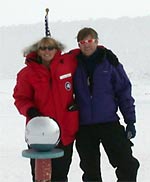|
|

|
|

|
Mary
and Noel's requisite "Hero shot." Click to enlarge.
|

|
|
|
|

|
|
Welcome
to the South Pole
|

|
Science
at the Bottom of the World
by Mary Miller
January
3, 2002
There’s
a tradition for anyone visiting the South Pole to get what’s
known as the "hero shot." The location for the hero
photo is not far from the geographical South Pole, where all
lines of longitude meet at the southern most part of the globe
at 90 degrees south. Navigation here is a little tricky: After
all the rest of the world is north of the South Pole in any
direction you choose. To make sure that planes fly in the
correct direction when they leave the pole, a grid system
has been established which actually places McMurdo Station
to the south of the south pole.
The location of the geographic South Pole marker drifts about
30 feet a year carried along by the flowing ice sheet that
covers the continent’s interior. Every January 1st, the
US Geologic Survey relocates the geographic pole. Standing
by the new marker feels significant, as if the whole world
were revolving under your feet. All around you is a sea of
flat ice two miles thick, met at the horizon by brilliant
blue sky. The air is so clear here that you can actually see
the curvature of the earth. The air is also very thin because
the South Pole is on a mountain of ice, which raises our altitude
from sea level to 10,000 feet. The altitude makes is tough
for newcomers to move around without losing their breath,
so our first few days at the pole we took it easy, drank lots
of water, and tried to rest in between taking tours and getting
acquainted with the people and science of this remarkable
place.
|
|

|
|

|
A
view out the window, where you can see the curvature of
the Earth. Click to enlarge.
|

|
|
|
|

|
The
ceremonial South Pole, where hero shots are traditionally
taken, doesn’t change its location on top of the ice.
Every year it drifts with the ice closer to the station, known
as the Amundsen-Scott South Pole Station after the two explorers
who first made their way to the spot early in the 20th century.
The ceremonial pole is a simple re-and-white striped pole
with a reflective ball on top, surrounded by the flags of
the countries that were original signatories of the Antarctic
treaty.
On our tour of science at the South Pole, the ceremonial pole
was the first stop we made so we could get our "hero
shot." Then we trudged across a snow runway where ski-equipped
military transport planes land and take off. After a slow
half-mile, we finally arrived at the "dark sector."
The dark sector houses several telescopes located far enough
away from the main station to keep the lights and electronic
transmissions there from interfering with sensitive detectors.
During the Antarctic summer, most of the activity in the dark
sector is geared towards getting the telescopes ready for
the winter observation season when the skies are dark, cold,
and very very dry.
|

